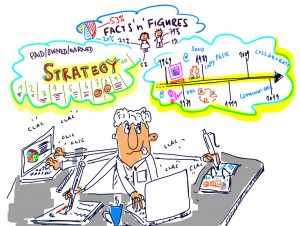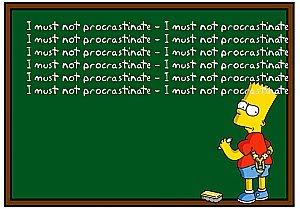Category Archives: Uncategorized
7 Things Your Body Needs to Ace Your Exams

Earlier this week, we published a post with seven general tips to help you study that you may not already know about. Since studying for finals can be stressful on your brain, we want to show you a few unique ways to boost your brainpower during this crucial time.
Here are seven tips that will help your body (and brain!) function at their best:
1. Drink lots of water.
The brain is a complex electrical system that uses water to transmit information. You need plenty of water to learn and to stay focused. Drink coffee and energy drinks if you need to, but just remember that caffeine is a diuretic–it makes you go to the bathroom more often, which will dehydrate you if you don’t replace the water.
2. Chew gum while you study.
Chewing gum while you study can increase your brainpower because the chewing motion increases bloodflow to your brain. It’s also a really good idea to chew gum right before your take your test. (Quick note: peppermint and cinnamon both make you more alert, so reach for a stick of Wrigley’s Big Red or Doublemint.)
3. Take a 10 minute break for every 50 minutes of work.
According to the Dartmouth Academic Research Center, you should study in 20-50 minute increments and give yourself a 5 to 10 minute break between each session
4. Move during your breaks.
Go for a quick walk if you can on your breaks. Swing your arms across the mid-line of your body like you are power-walking to turn on both sides of your brain. If you don’t have the space, you can do this standing in place.
5. Lengthen the muscles in the back of your body.
Take a minute or two to stretch out your hamstrings and lower back. The muscles in the back of your body tighten up when you sit too long. Tight muscles leads to unfocused minds.
Here’s one easy exercise you can do: Extend your legs in front of you while you’re sitting and cross one ankle over the other. Then, lean over your legs and reach towards your feet with extended arms.

6. Use all your senses when you study.
Using all your senses helps create more pathways in the brain. Try using diagrams and mind maps with colors. Write out your notes to get your tactile sense involved. Marching around the room while speaking out loud can help you memorize facts.
7. Don’t listen to music with words.
When you listen to music with words, even in the background, the lyrics compete with the information you’re trying to learn. If you like listening to music while studying, choose instrumental or classical music like Mozart.
Put a few of these tips to good use and then tell us which ones worked best for you! And feel free to share with your friends if these tips are helpful for you.
Woman drinking water image and woman hearing image via photoxpress.com
The 7 Surprising Study Tips that You Don’t Already Know
 You’ve probably already heard some of the typical advice about studying: start one full week ahead so you don’t cram, make a study plan, study in concentrated chunks over time, use study cards, rewrite your notes, study in an environment where you can concentrate, etc.
You’ve probably already heard some of the typical advice about studying: start one full week ahead so you don’t cram, make a study plan, study in concentrated chunks over time, use study cards, rewrite your notes, study in an environment where you can concentrate, etc.
But here are seven tips you probably have never heard of:
- Don’t multitask. Shut off all distractions. Turn off your phone, even shut off your internet if you feel too tempted. (You can use computer programs like Freedom and Leechblock to make Facebook and other sites impossible to access for part of the day.) Multitasking splits your brain’s resources so you can’t process information as well. In fact, research shows that if you multitask all the time, it actually changes your brain permanently so that you lose the ability to focus deeply on a task.
- Ask your professor or TA for help. Even stop by the office during office hours. Most students are afraid of bothering their professors or TA’s if they go to office hours. The opposite is usually true. When I was a professor, students who came to me during office hours struck me as serious students who were engaged in their learning.
- Predict your test questions. Test yourself by reciting and/or writing out possible answers to questions. Even if you don’t predict the right questions, putting yourself in your professor’s shoes will help deepen your understanding of the material.
- Use mind-mapping. Mind mapping is the most effective way of reviewing your notes if you’re a visual learner because it helps organize all the details into a structure you can understand.

- Review your notes before your sleep. Sleeping after you read something is proven to help you remember the information more clearly the next day. This doesn’t mean you should cram it all in the day before. But a quick refresher the night before your test will help you remember more.
- Study in different locations. Rather than sticking to one study spot, you should switch things up when reviewing for exams. Simply alternating the room where you study helps you remember better. That’s because learning in different environments forces the brain to make multiple associations with the same material, which helps you remember information for longer.
- Use your mind to imagine success. There are lots of ways to lower your anxiety on test day. But here’s a really powerful tip: Spend some time before the exam imagining yourself acing it. Play a movie in your mind, imagining everything going great from the moment you wake up on the day of the exam to the moment you finish the exam.
Put these tips into action while you study. And then leave us a comment below to tell us which one helps you the most!
Source: mindmap image via dmje
multitasking image via stoneysteiner
Cure for Procrastination? Forgive yourself!
 There are so many things you’d rather be doing than what you ought to be doing and what happens is that you delay doing what you ought. All the evidence shows that this procrastination is bad for you, for your productivity, even for your health. But still we keep putting things off. Until. Tomorrow. Now Michael Wohl and colleagues have proposed a rather surprising cure – self-forgiveness. That’s right, forgive yourself for you have procrastinated, move on, get over it and you’ll be more likely to get going without delay next time around.
There are so many things you’d rather be doing than what you ought to be doing and what happens is that you delay doing what you ought. All the evidence shows that this procrastination is bad for you, for your productivity, even for your health. But still we keep putting things off. Until. Tomorrow. Now Michael Wohl and colleagues have proposed a rather surprising cure – self-forgiveness. That’s right, forgive yourself for you have procrastinated, move on, get over it and you’ll be more likely to get going without delay next time around.Wohl’s team followed 134 first year undergrads through their first mid-term exams to just after their second lot of mid-terms. Before the initial exams, the students reported how much they’d procrastinated with their revision and how much they’d forgiven themselves. Next, midway between these exams and the second lot, the students reported how positive or negative they were feeling. Finally, just before the second round of mid-terms, the students once more reported how much they had procrastinated in their exam preparations.
The key finding was that students who’d forgiven themselves for their initial bout of procrastination subsequently showed less negative affect in the intermediate period between exams and were less likely to procrastinate before the second round of exams. Crucially, self-forgiveness wasn’t related to performance in the first set of exams but it did predict better performance in the second set.
‘Forgiveness allows the individual to move past maladaptive behaviour and focus on the upcoming examination without the burden of past acts to hinder studying,’ the researchers said. ‘By realising that procrastination was a transgression against the self and letting go of negative affect associated with the transgression via self-forgiveness, the student is able to constructively approach studying for the next exam.’
http://bps-research-digest.blogspot.com/2010/05/cure-for-procrastination-forgive.html?The cure for procrastination? Forgive yourself!
_________________________________
Five ways to get moving when you’re procrastinating
- Do contralateral moves, such as marching in place, lifting your knees up and touching your opposite knee with your opposite hand. This helps activate both sides of the brain. You need both hemispheres to be able to get ideas and also implement them. When you are blocked you tend to be using only one hemisphere.
- Visualize yourself doing what you need to do. Studies show that even when you visualize doing something without actually doing it you activate the necessary muscles and the necessary parts of the brain. If you are procrastinating about doing something just visualize yourself doing it. See yourself smiling while you are doing it.
- Notice your self talk. When you are telling yourself harsh things about feeling blocked and not being able to get started you respond as you did in the past to an authority figure. You may avoid and procrastinate. Notice your behavior without the story. The stories might include “I’m such a failure because….”, “I can’t believe that I can’t…..” The stories we tell ourselves about our perceived failure to act keep us in the resistance and what we resist, persists. Just notice what we are doing without the judgement: “ I notice I’m sitting here wasting time and not starting to do what I want to do”. Without the story we are more likely to be able to get in touch with what we need to be able to move forward. Is it more information, more resources, more focus? Pretend you are a person who comes to you and says, “I’m procrastinating and can’t get started”. What would you tell this person? Now tell yourself this.
- Pick one small thing you could do this very minute and do it. Do it just for the pleasure of doing it. Shut off all voices of judgment that what you’re doing is not big enough or important enough. After you finish doing this, make another very small goal and do it. Usually when we’re blocked we don’t see how we can do the task because we feel that we have to do it all perfectly or all at once. We forget that all tasks are composed of smaller steps.
- It’s helpful to do some free-flow writing. Just write about anything that comes to mind. If you feel blocked about writing then draw some magic eights on a piece of paper. Draw a large eight on its side by going first to the left and then to the right. Keep your eyes focused on the tip of your pencil while you keep your head still. Allow only your eyes to move across the paper. What you need to be focused on is the eye activation of moving your eyes across the visual midfield. Now do a couple of magic eights and then print an “a” on the left side of the eight. Next do two more magic eights and print a “b” on the right side of the eight. Next do 2 more magic eights and print a “c” on the left side. You will find that your ideas will start flowing as you draw these letters. You can do other letters of the alphabet in the same way.
What TV does to the developing brain
I was at a downtown festival in my city and ran into one of my middle son’s Montessori teachers. She shared that she was finishing up a really challenging year because of several “difficult” children. She stated that every year she seemed to get more children with learning and attention issues. I asked her to describe what types of issues these children have and she mentioned attention problems, issues with learning and social relationships. I asked her why she thought that children seemed to be coming to school with more problems and she said, “I think one of the reasons is that children don’t have enough downtime without computer games, movies, TV, where they can get outside and just play. Parents think they always need to be entertained”. She went on to add that when parents pick their children up from school they watch a movie in the car DVD player instead of looking out the window and talking about what they see.
I was reminded of what Joseph Chilton Pearce says in Evolution’s End, Claiming the Potential of Our Intelligence, that television, (and we can now include computer games), causes neurological damage to children. According to him, our society is not evolving, rather it is devolving and one of the main causes is TV. Television replaced storytelling and substituted for family conversations at the dinner table. In addition, television replaced parents playing with their children and decreased the amount of time siblings play. This is a great loss as play helps develop internal imaging. Television floods children with images at the very time they start to learn to create their own internal images. Therefore, they lose the ability to create their own images and therefore lack imagination.
How does this inability to create image affect learning in school? They can’t “see” what the mathematical formula, word or chemical formula means. They can only sense what is immediately bombarding their physical senses and are restless and uncomfortable without this bombardment. Being sensory deprived, they seek out more stimuli through restless activity. Joseph Chilton Pearce says that a child that cannot imagine cannot learn.
My children were brought up without television. It happened the day a storm blew over our antenna on our roof. Up until that time they were allowed to watch “Sesame Street” and “Mister Rogers”. My husband and I liked to watch the news. There was a segment about the guerrillas fighting in Afghanistan. That night and the next few nights my middle son could not go to sleep because of his fear of the “gorillas” coming to get him. My husband and I decided to not pay for cable because of this incident and because of the addictive power of TV for us and our children. I wanted my kids playing downstairs in the basement or outside. They spent hours playing dress up, swashbuckling sword scenes, and “Star Wars” scenes.
They put on puppet shows and plays. They were allowed to watch movies occasionally and when they got older, play some computer games. We went to the library every week and checked out 30 or 40 books. They would read them in the car all the way home from the library and then when we got home we would have cut up apples and cheese and I would read to them as we sat on the sofa, one in my lap, and one on each side of me. At that time, I was just introducing them to my love of books and did not know that I was building their imaginations, establishing neural networks, laying down the necessary building blocks of learning.
Gifts of the right brain
 Bored in School? Are schools honoring the creative child?
Bored in School? Are schools honoring the creative child?
So what are the gifts of the right brain? If we are to create solutions to problems that we don’t even know we’ll have, we know that the answer will come from the inspired thoughts from our right brain, our innovative brain. For a very clear description of the experience of thinking with the right brain see Jill Bolte Taylor talk about Her Stroke of Insight http://www.youtube.com/watch?v=UyyjU8fzEYU
Of course, it’s simplistic to think that we can do without the left hemisphere abilities since that’s the side that can implement the wonderful ideas of the right hemisphere. Still, I wish our culture would honor these “right brain” thinkers more.
Linda Silverman, Ph.D, is the Director of the Gifted Development Center in Denver, CO. She has done some interesting research showing that 1/3 of a sample of 750 students in grades 4, 5 and 6 were strongly visual/spatial, that is right brain dominant, whereas only ¼ were strongly auditory/sequential, left-brain dominant. The visual/spatial learners think in pictures rather than in words. They need to see the big picture before they can understand the details. They learn all at once, and when the light bulb goes on their learning is permanent. They don’t learn from repetition and drill and don’t learn step-by-step the way most teachers teach. They can get to solutions without knowing how they got there so being asked to “show their work” may be impossible for them. According to Silverman, “They are systems thinkers who can orchestrate large amounts of information from different domains, but they often miss the details.” They right-brain thinkers are not organized and are unaware of time but may be gifted creatively, technologically, mathematically, or emotionally.
So how are schools honoring these learners?
Fun at my last Brain Gym class!
Now that I finally finished grading the tests and papers from the graduate courses I teach I decided to sit down and write about my latest Brain Gym class. I trained 25 teachers in this latestBrain Gym 101 class and what a wonderful group they were! I always think the teachers and parents who are attracted to this “play” are so open to new ideas and eager to help children learn.
It was cool to see so many Continue reading Fun at my last Brain Gym class!



